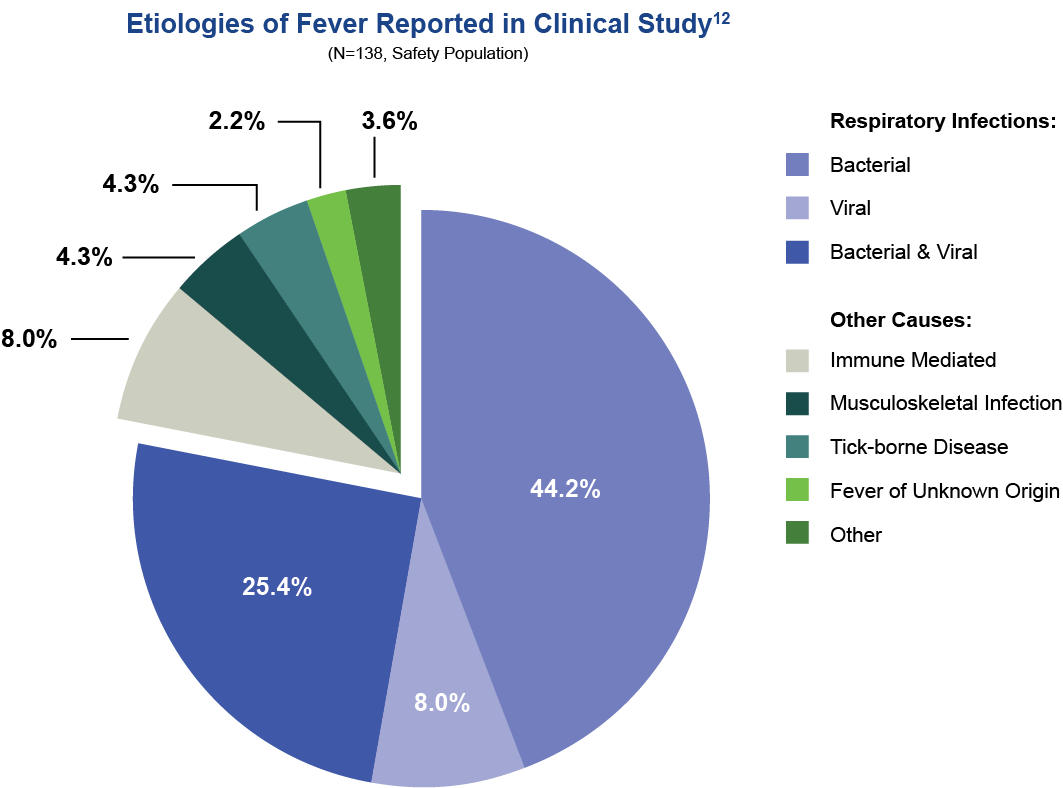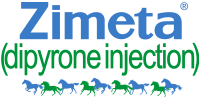ORDER NOW!
Contact your Dechra or Distributor Representative or call (866) 683-0660.
About Fever in Horses
Reasons why horses may experience elevated body temperature
In horses, elevated core body temperature (greater than 101.5°F) is the result of either hyperthermia or pyrexia (fever). Hyperthermia conditions include exercise-related hyperthermia, heat stroke, and reactions to certain toxins or drugs. In general, these conditions do not respond to antipyretic drugs.1
In a true fever, the set point for the physiologic core body temperature increases as a response to infection or inflammation. Although there are documented benefits of fever in many disease processes, managing fever also has benefits, particularly in the horse.1
Fever takes valuable energy
Nutrition is an important part of managing and treating sick horses. Fever increases caloric needs of horses, and inadequate nutrition may result in impaired immune system function, delayed wound or fracture healing, and/or muscle wasting.2
Fever can have serious secondary effects
Managing fever in a sick horse is important to help offset potential negative sequelae, including weakness, muscle wasting, and weight loss.1
Well-documented secondary effects of fever can include anorexia and decreased water intake, which may be associated with gastrointestinal impactions.1,3,4,5
Common causes of fever in horses
Fever is a clinical sign commonly associated with various underlying infectious and non-infectious diseases in the horse. Transportation of horses often results in fever, with incidence increasing with greater travel time and distances. One study showed fever occurred in 47.2% of clinically normal horses with no prior history of respiratory disease following transport.6
Diseases that may present with fever as a clinical sign include:
• Pneumonia/Pleuropneumonia7
• Acute diarrhea8
• Duodenitis/Proximal jejunitis8
• Internal infections10
These diseases are often associated with endotoxemia, a risk factor for sequelae including laminitis.11

“I’m really happy to have Zimeta and feel secure in using an FDA-approved product. In my experience, dipyrone is terrific for treating pyrexia. Fever is often a ‘handle’ to evaluate progression or improvement over time. With dipyrone, we can see if the fever is persistent or resolved over a short period of time. I can more accurately adjust targeted or supportive treatment.”
Sign up to receive future communications about Zimeta
For more information:
Contact your Dechra Representative
or call (866) 683-0660.
To place an order now:
Contact your Dechra Representative, Distributor Representative, or call (866) 683-0660.
Zimeta is indicated for the control of pyrexia in horses
As with all drugs, side effects may occur. Zimeta®(dipyrone injection) should not be given more frequently than every 12 hours due to the prolongation of prothrombin time (PT) and associated clinical signs of coagulopathy. For use in horses only. Do not use in horses with a hypersensitivity to dipyrone, horses intended for human consumption or any food producing animals, including lactating dairy animals. Not for use in humans, avoid direct contact with skin and keep out of reach of children. Care should be taken to avoid accidental self-injection and routine precautions should be used when handling and using loaded syringes as dipyrone can cause a deficiency in specific white blood cells in humans. Prior to use, horses should undergo a thorough history and physical examination by a veterinarian. Monitor for signs of abnormal bleeding and use caution in horses at risk for hemorrhage. Concurrent use with other NSAIDs, corticosteroids and drugs associated with kidney toxicity, should be avoided. Safety has not been evaluated in horses less than three years of age, horses used for breeding, or in pregnant or lactating mares. As a class, NSAIDs may be associated with gastrointestinal, kidney, and liver toxicity. The most common adverse reactions observed during clinical trials were elevated glucose conversion enzymes, decreased blood protein, gastric ulcers, inflamed or reddened lining of the right dorsal colon, and increased clotting times. Please see product insert for full prescribing information or visit www.dechra-us.com.
References
- Hines M. Clinical Approach to Commonly Encountered Problems. In: Reed SM, Bayly WM, Sellon DC, eds. Equine Internal Medicine. St. Louis, MO: Elsevier; 2018: 232-310.
- Ralston SL. Feeding Sick Horses. In: Merck Veterinary Manual (Merck and the Merck Manuals. Merck & Co., Inc., Kenilworth, NJ, USA). Available from: https://www.merckvetmanual.com/management-and-nutrition/nutrition-horses/feeding-the-sick-horse?query=Feeding%20the%20Sick%20Horse. [Access Date: March 1, 2021].
- Collatos C, Romano S. Cecal impaction in horses: causes, diagnosis, and medical treatment. Compend Contin Educ Pract Vet. 1993;15:976–982.
- Dabareiner RM, White NA. Large colon impaction in horses: 147 cases (1985–1991). J Am Vet Med Assoc. 1995;206: 679–685.
- Plummer AE, Rakestraw PC, Hardy J, et al. Outcome of medical and surgical treatment of cecal impaction in horses: 114 cases (1994-2004). J Am Vet Med Assoc. 2007;231(9):1378-1385.
- Maeda Y, Oikawa MA. Patterns of Rectal Temperature and Shipping Fever Incidence in Horses Transported Over Long-Distances. Front Vet Sci. 2019;6:27.
- Arroyo MG, Slovis NM, Moore GE, et al. Factors associated with survival in 97 horses with septic pleuropneumonia. J Vet Intern Med. 2017;31:894-900.
- Cohen ND, Woods AM. Characteristics and risk factors for failure of horses with acute diarrhea to survive:122 cases (1990-1996). J Am Vet Med Assoc. 1999;214:382-390.
- Cohen ND, Parson EM, Seahorn TL, et al. Prevalence and factors associated with development of laminitis in horses with duodenitis/proximal jejunitis: 33 cases (1985-1991). J Am Vet Med Assoc. 1994;204:250-254.
- Pratt SM, Spier SJ, Carroll SP, et al. Evaluation of clinical characteristics, diagnostic test results, and outcome in horses with internal infection caused by Corynebacterium pseudotuberculosis: 30 cases (1995–2003). J Am Vet Med Assoc. 2005;227(3):441-448.
- Parsons CS, Orsini JA, Krafty R, et al. Risk factors for development of acute laminitis in horses during hospitalization: 73 cases (1997-2004). J Am Vet Med Assoc. 2007;230(6):885-889.
- Data on file. REF-0155. Dechra Ltd.
Zimeta® is a registered trademark of Kindred Biosciences, Inc. in the United States and/or other countries.
© 2021 Dechra Veterinary Products, LLC. All rights reserved.

